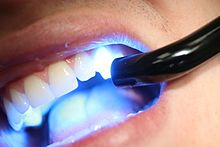Curing light
In dentistry, a polymerisation device is used to harden ( polymerise ) composite fillings . Halogen lamps or light emitting diodes (LEDs) serve as light sources . A distinction is also made between mains and battery-operated devices. The latter are more flexible to use (because they are wireless).
Polymerization devices must generate a cold light ( cold light source ). With the high luminance required to light-cure the composite filling, the generation of heat associated with the generation of light could otherwise damage the tooth pulp .
Halogen lamps
Halogen lamps produce a lot of heat than incandescent lamps. Their light output is less than one percent. Such devices must therefore be intensively cooled with a built-in fan. Halogen lights decrease significantly in their luminosity over the course of two to five years.
Led Lamps
Newer types of devices are often equipped with LEDs as a light source. LEDs were first proposed in the literature for photopolymerization of dental composites in 1995 . With a luminous efficacy of 7%, they generate significantly less heat than halogen lamps and require less electricity, which is why they can be used in cordless tools. LEDs also show a decrease in luminosity over the years. Blue LEDs have a wavelength of 450–490 nm and are therefore well suited for the photoactivation of camphorquinone. An overview of the development of LED curing lights in dentistry was published in 2013.
Studies have shown that the luminance specified by the manufacturer is often undercut even with brand-new devices, decreases sharply in everyday use in the dental practice and often only 50% of the specified luminance is present.
The distance between lamp and filling is decisive for the luminous efficiency. The light beam emerges from the light guide in a cone shape, so the light output decreases with the square of the distance.
Conventional curing lights emit their full light output as soon as they are switched on. On the other hand, with soft start polymerization, the light output is reduced for the first 10 to 20 seconds and only then is it automatically increased to full light output. The underlying theoretical concept, the reduction of internal stresses in the composite, could not be confirmed either [in vivo] or [in vitro]. Soft start polymerisation does not damage the treatment result as long as sufficient light output is given to the filling, but it does not bring any advantages either.
Absorbed dose
The energy dose required to polymerize composite fillings is 12,000 to 16,000 mJ / cm² (12 - 16 J / cm²). A further supply of energy above this energy dose does not bring about better polymerization, it can only lead to a harmful increase in temperature on the tooth, which could lead to pulp damage.
The depth effect of the light falls exponentially within the composite filling, which is why deep fillings have to be cured in several layers. Composite materials are translucent to different degrees; The maximum effective penetration depth of the light varies accordingly from material to material.
Precise measurements of the light intensity are possible with the integrating sphere . In practice, however, the measurement is limited to a much cheaper radiometer, which is often integrated in the devices.
Individual evidence
- ↑ Mills RW. Blue light emitting diodes - another method of light curing? British Dental Journal 1995; 178: 169.
- ↑ Mills RW, Uhl A., Blackwell GB, Jandt KD High power light emitting diode (LED) arrays versus halogen light polymerisation of oral biomaterials: Barcol hardness, compressive strength and radiometric properties. Biomaterials 2002 Jul; 23 (14): 2955-63
- ↑ Jandt KD, Mills RW. A brief history of LED photopolymerization. Dental Materials 2013; 29: 605-617.
- ↑ Ernst CP, Meyer GR, Muller J., Stender E., Ahlers MO, Willershausen B. Depth of cure of LED vs QTH light-curing devices at a distance of 7 mm] J Adhes Dent 2004 Summer; 6 (2): 141-50
- ↑ Lussi A., Zimmerli B., Aregger T., Portmann P. Composite curing with new LED devices. Switzerland Monthly Zahnmed, Vol 115: 12/2005, 1182-1187
- ↑ Uhl A., Mills RW, Jandt KD Polymerization and light-induced heat of dental composites cured with LED and halogen technology. Biomaterials. 2003 May; 24 (10): 1809-20




